
Although wasps are not the most dangerous pests of grapes, they can nevertheless significantly spoil the appearance of the grapes. For winegrowers who grow fruits for direct sale, this is especially important - sometimes literally two or three insect-bitten berries completely deprive the bunch of its commercial appearance. In such cases, the desire to protect the grapes from wasps is quite understandable, because it is directly related to the issue of profitability of growing the crop.
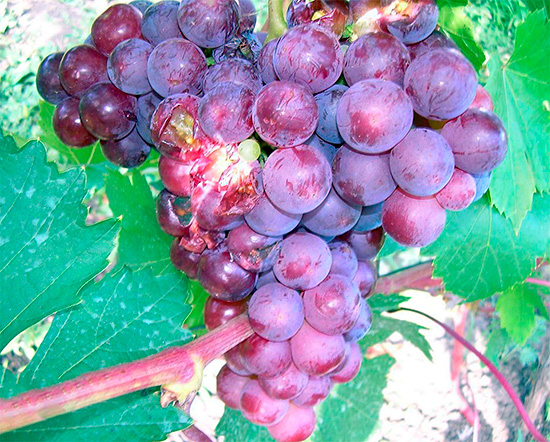
In addition, in most cases, wasps do not eat out the berries already damaged by them, but begin to gnaw and spoil new ones, indiscriminately: clusters already damaged, and still untouched. As a result, even a relatively small number of insects can spoil a significant proportion of the ripened crop.For processing for the preparation of wine, he, of course, fit, but to sell such damaged grapes will be more difficult, and it will be stored much less time.
Feedback
“I have wasps of grapes regularly beaten, and at the time of harvesting not a single untouched bunch remains. Incidentally, I noticed such a nuance: the wasp could gnaw the pulp in the berry, and then after the meal, make a couple of punctures on the neighboring grapes. Under these punctures, the pulp begins to roam, and in a couple of days the insects return here precisely because of such a “braga”. And they do not really eat, but spoil a lot. ”
Konstantin, Volgograd
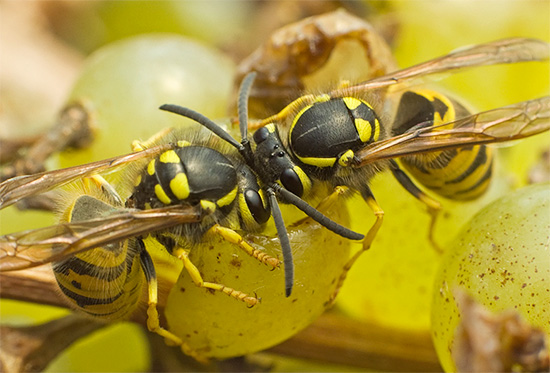
The question of how to protect the crop and save it from regular “raids” has been bothering winegrowers for decades, and today skilled gardeners have developed many effective ways to protect the grapes from wasps. All these methods can be divided into two groups - active and passive.
The first ones work according to the principle “the best defense is attack”, and the end result of their implementation is the direct destruction of the pests themselves: if not all, then at least the main part of them.Under certain conditions, these methods of dealing with wasps on grapes turn out to be very effective, but sometimes they are dangerous for the person himself.
The second group - passive methods of struggle - allows to save grapes from wasps, creating an insurmountable mechanical barrier for insects. Such methods can be considered sparing and more environmentally friendly. After all, it should be remembered that the wasps, being pests of grapes, partly help the vineyard itself in the fight against other unwanted insects: the wasps are actively destroying in areas of bedbugs, grasshoppers, caterpillars, aphids, which are also not averse to eat sweet berries. Therefore, despite the complexity, such a barrier protection of grapes from wasps is used quite often - and the wasps are full, and the clusters are intact.
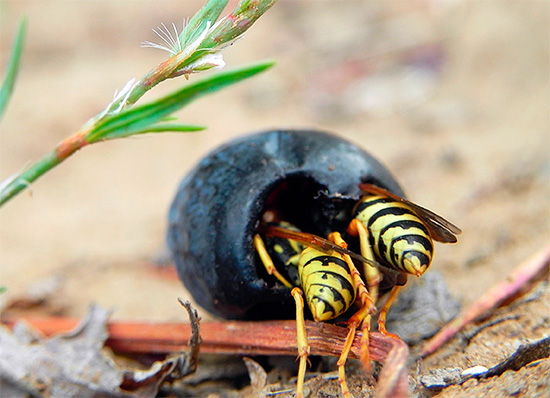
All ways to protect grapes
Now let's talk in more detail about how you can save your crop from wasps, and be able to protect it from these insects throughout the season.
Active ways to protect grapes include the following approaches:
- Destroying the nest of wasps - if their home is to be liquidated before the grapes ripen, then there will be no one to spoil it.However, this method is only suitable for small private vineyards and situations where the gardener knows exactly where the nest is located on the site, because looking for it (and it may not be the only one) outside the vineyard, and even more so - in a foreign garden or garden extremely difficult.

- Fighting wasps in the vineyard with the help of special traps.

- And the third way is the extermination of insects with the help of poisoned baits (for small farms, sometimes this is the best way to save grapes from wasps).
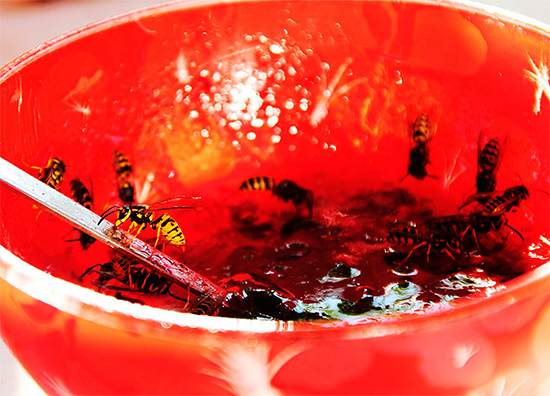
Passive methods of control usually do not lead to the death of winged pests. These include:
- Scaring wasps from a vineyard is a rather ambiguous method, in which the clusters and bushes themselves are sprayed with deterrent chemicals. This method allows you to protect the crop, but in the future requires serious preparation of grapes for human consumption - it must be thoroughly washed from chemicals.
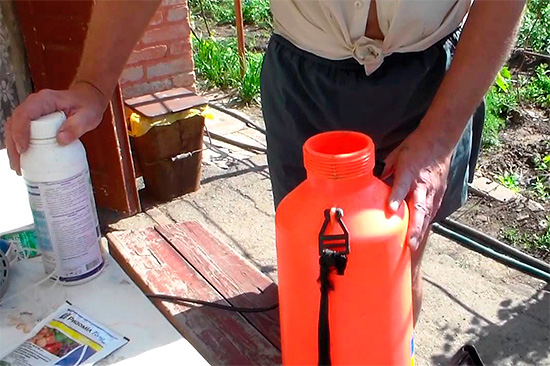
- Packing ripened grapes in special mesh protective bags. Perhaps this is the most reliable method of protecting grapes. However, it is very laborious and costly: for example,if in a farm with 30-40 bushes all the clusters can still be relatively easily hidden in such bags, then for hundreds of bushes such packaging will require a very large amount of work and cost for the nets themselves.
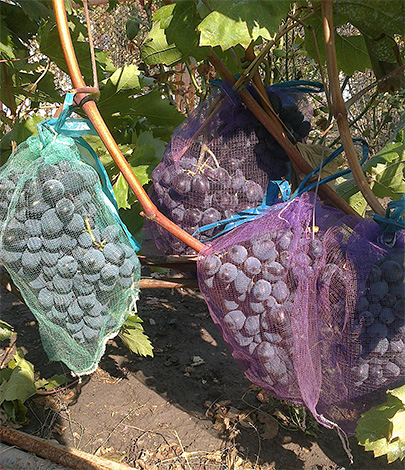
As you can see, you can save your harvest in different ways, but in fact, choosing the most appropriate way to deal with wasps on grapes is not so difficult:
- if a nest is found on the plot, it is destroyed first;
- if there are no wasp nests at the site, and there are a lot of grapes, then traps and / or poisonous baits are placed between the rows of bushes to save valuable grapes from mass sabotage (the design and manufacture of such traps and baits will be discussed below);
- on an industrial scale, it is possible to save the grapes from wasps by spraying the bushes with insecticides, and after harvesting, wash the berries in special devices;
- in small farms with expensive grape varieties, clusters are rationally hidden in protective bags.
Feedback
“We were furious when we began to notice that half of our elite Red Rose was literally biting into wasps. And the wasps do not eat the grapes completely, but only gnaw the bottom of the berries to the level of the seeds and leave such hanging peels to dry. Nightmare. We didn’t even know what to do.Neighbors said that you can wear special bags for grapes from wasps to protect the bunches. We immediately bought such nets, but we have a lot of grapes, and nets of money cost, as it were, considerable in total. The Red Rose was closed, and the wine and all the green table was collected and then beaten. Here, for the new season we are preparing traps for wasps, I really do not want to face such a problem again. ”
Lyudmila, Tuapse
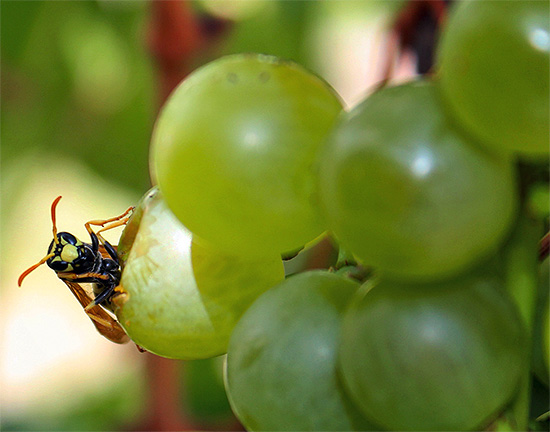
Wasp traps
The main advantage of traps for wasps is their high efficiency and simultaneous safety for humans - they can be used to get rid of pests without risking being bitten and sprinkling grapes with potentially dangerous chemicals.
Such traps are made from ordinary plastic bottles. The upper third of the bottle is cut off, turned upside down and inserted into the lower part. Beforehand, the bait is poured into the lower half: beer with sugar, fermented jam, home brew or kvass with bread.
Photo traps for wasps:

Important!
You should not use as a bait a solution of honey or a sweet syrup, which can be flown by useful and non-spoiling grapes.
The wasp, having penetrated the inverted neck into the bottle, will not be able to get out of the trap: instinctively flying up along the walls, it will not be able to find a way out, and as a result it will simply drown in the liquid bait. If you set up on the site and regularly fill these traps from the beginning of summer, you can almost completely get rid of wasps on grapes.
Practice shows that a day in one such bottle can fly from a few dozen to a couple of hundred insects. Traps can be hung on supports for grapes, placed in conspicuous places among the rows: the more they are, the more reliably you can save your crop (experienced gardeners recommend installing at least one trap around each bush).
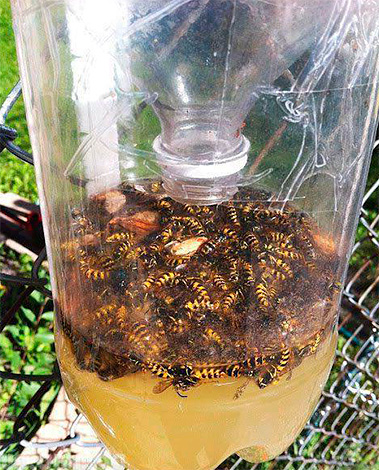
Poisonous bait and grape safety
One of the most effective ways to protect the grapes from wasps is to use poison baits. Some of these tools lead to the death of insects only a few hours after eating, while others begin to act almost instantly.
It is worth noting that choosing this method of protection of grapes, you need to remember one important feature: the bait should not have a strong "chemical" smell (otherwise the wasps will simply ignore it).To date, there are a number of toxic agents that meet this requirement - for example, the powerful insecticidal drugs Lambda Zone, Delta Zone, Get, and some others. All of them have almost no odor, are relatively safe for humans and domestic animals, but at the same time they have an excellent poisoning ability against insects.
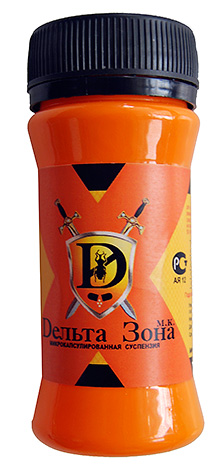
The lures are poured into saucers, cut off bottoms of plastic bottles or into wide circles and are displayed in prominent places around the grapes: the more they are on the plot, the more reliable it will be to protect the grapes. As insects eat and natural evaporation, the poisoned treat should be added.
As a basis for the preparation of a poisoned bait, sour jam, beer or kvass with sugar is usually used, in which, in addition to the above preparations, you can also add boric acid or chlorophos in a ratio of 10: 1 (10 parts of the base are taken per insecticide). Boric acid and chlorophos also have no odor, and therefore for insects in the composition of the treat will be invisible.
Sweet and easily accessible "delicacies" in saucers are well attracted by wasps flying on grapes, and as a result, soon after feeding, they lead to the death of insects.
Sometimes meat or lard, treated from above with boric acid or another odorless insecticide, is also used as bait. The wasps gnaw at small pieces and carry them to their nest where they feed the larvae and the uterus, which then die.
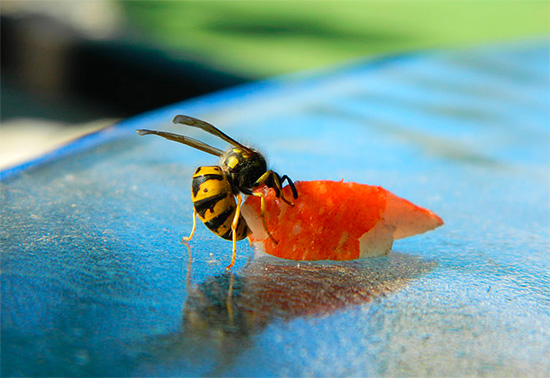
We destroy the nest of insects
The destruction of the nest of wasps - the operation is quite time-consuming and dangerous. The fact is that these insects, protecting the nest, can attack with a whole swarm, and therefore all actions should be carried out in thick clothes, a beekeeper's mask and, if possible, at night.
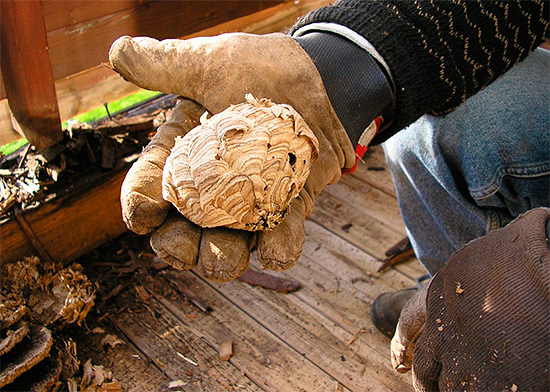
Usually, the wasp nests are located under the roofs of outbuildings, in cavities under slate, between the finishing material and the wall of the house itself, in the cavities of the pipes.
There are several ways to destroy a nest:
- pour gasoline and burn;
- drown in a bucket of water;
- put in a bag with an insecticide solution pre-poured into it;
- spray aerosol insecticides onto the house.
Choosing the first option of destruction (incineration), it is necessary to remember about fire safety measures - the wasp nest is built of paper-like material, so it flares up well and quickly. At the same time there is a serious danger of moving fire to the nearest buildings or trees.
To sink the dwelling of the wasp, you will need a stepladder suitable in height, which can be used to prop up a bucket of water from the bottom, pressing it along with the nest inside to the ceiling.

Treatment with insecticidal aerosols usually has to be carried out several times - for each dose the preparation will destroy a significant number of adult insects and larvae (some of the wasps will fly apart). Of course, this method requires a systematic approach, but it is relatively simple to implement and, at the same time, rather effective.
To destroy a particularly large or hard-to-reach nest of wasps, you can also call fire brigade or a special brigade of exterminators. In many cases, this allows not only to save the grapes, but also to protect the owners of the site from regular snacks.
Bags of mesh to protect the grapes: the rules of application, advantages and disadvantages
Even before the appearance of specialized protective bags made of fine mesh, old women's tights were used, which were simply covered with grapes. It allowed to protect grapes from wasps with great reliability.
However, as the grapes ripen, the berries in such a grid choke, and therefore the question arose of the need for a specialized solution.So there were bags to protect the grapes from wasps made of thick polyethylene mesh on strings, which freely fit the bunch and do not limit it in growth. Today, grape-sized nets of three-liter jars are available for sale.
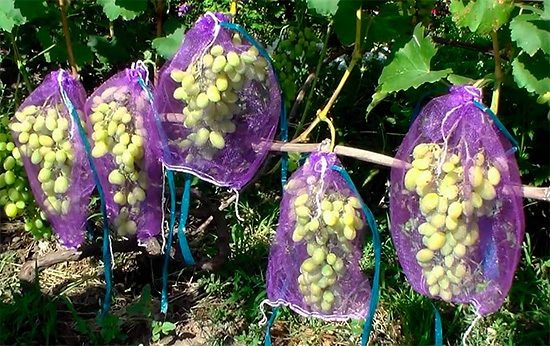
The main disadvantage of such bags for grapes is the complexity of their use with a large number of bushes. However, they provide the most reliable protection of the grapes, can do without the use of insecticides and can be used for several years in a row.
Put the bags for grapes on the bunches should be when the first berries are beaten by insects. In this case, you should always use bags with a margin in size.
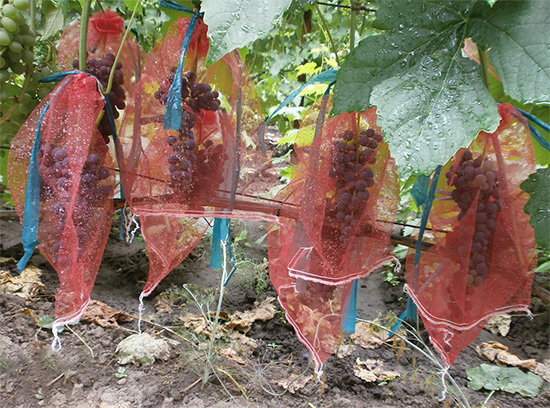
Wasps can be repulsed from grapes by spraying it with special substances - either strongly smelling or toxic to insects.
There are also some folk remedies for this purpose: experienced gardeners recommend, for example, the use of vinegar - wine or ordinary table. It is easily washed off from clusters by rain, non-toxic, but at the same time allows it to temporarily scare away wasps and maintains its effect for several days or even weeks.
You can also treat the grapes with Tiovit Jet, Kinmiks and some others like them, but after harvesting it will be necessary to thoroughly wash all the clusters of chemicals.
It will also help scare away wasps from grapes liquid smoke, which is usually used in household smokehouses - they are tilled with soil under bushes. The smell of smoke, as a rule, scares wasps, however, as practice shows, the effectiveness of this tool is still very limited, and even after using it, some of the grapes are still damaged.
Useful video with a good example of protecting grapes from wasps
Making very effective traps for wasps with their own hands and demonstration of their work



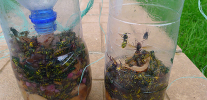
I heard that you can spray a bunch of grapes with whey from under the curd, but I don’t know how exactly.
Another solution is sprinkled with salt.
Tried, berries are showered.
If you spray wasps with solarium, they immediately get lost and fall.
How much beer and sugar do I need to trap on wasps?